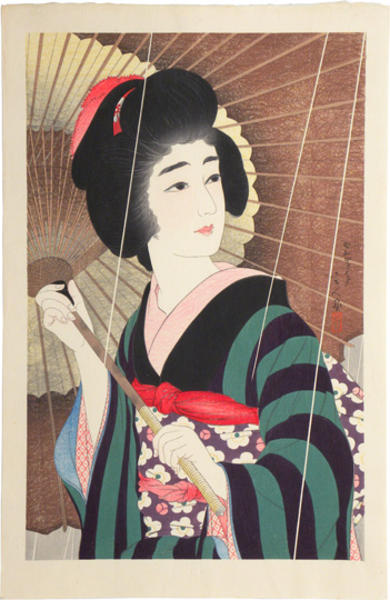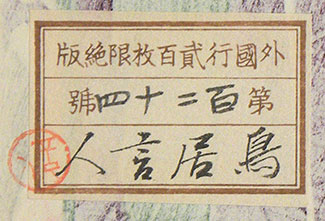| | |
| Artist: | Torii Kotondo (1900-1976) — 鳥居言人 |
| Title: | Rain (Ame) — 雨 |
| Series: | |
| Date of first edition?: | 1929/10 |
| Publisher (first edition)?: | Sakai and Kawaguchi — 酒井川口 |
| Publisher (this edition)?: | Sakai and Kawaguchi — 酒井川口 |
| Medium (first edition): | Woodblock |
| Medium (this edition): | Woodblock |
| Format (first edition): | Large Oban
|
| Format (this edition): | Large Oban |
| DB artwork code: | 48056 |
| Notes (first edition)?: |
Artist Torii Kotondo
Title Ami (Rain)
Medium Original, Limited-Edition Japanese Woodblock Print
Date 1929
Publisher Kawaguchi/Sakai
Reference No Female Image, # 173
Size 16 x 10 "
Editions: 200 (S&K first edport edition), 300 (S&K first domestic edition).
Notes: Embossed title in the lower margin reads, "Ami" ('Rain'). Dated and signed center right, "Showa yonnen jugatsu Kotondo ga" ('Showa 4 (1929), October, picture by Kotondo'), followed by rectangular artist's seal reading "Torii".
Embossed joint publisher's seal in the lower left margin of Sakai and Kawaguchi. Blocks carved by Ito and printed by Komatsu Wasakichi.
Re-issued in the series "Twelve Aspects of Women" circa August 23, 1988. |
|
| Notes (this edition)?: |
| The following information was taken from the original web listing of this artwork. Note that there may be some inaccuracies:
Torii Kotondo
1900-1976
Rain
(Ame)
dated and signed at right, Showa yonnen jugatsu, (Showa 4 [1929], 10th month), Kotondo ga, followed by artist's rectangular seal Kotondo; the title, Ame, embossed on bottom margin, the publisher's seals embossed at lower left corner, Sakai Kawaguchi go ban (joint venture); the blocks carved by Ito and printed by Komatsu Wasakichi, with limited edition paper seal hand-numbered on verso, Gaikoku iki ni-hyaku mai kagiri zeppan, dai hyaku nijuyon go, Torii Kotondo (for foreign export, limited edition of 200 printed, number 124, by Torii Kotondo), 1929
dai oban tate-e 18 1/8 by 11 3/4 in., 46.1 by 29.8 cm
References:
Kato Junzo, comp., Kindai Nihon hanga taikei, 1975-76, Vol. 3, pl. 106
Amy Reigle Stephens, en. ed., The new wave: Twentieth-century Japanese prints from the Robert O. Muller Collection, 1990, p. 199, pl. 265
Lawrence Smith, Modern Japanese Prints 1912-1989: Woodblocks and Stencils, 1994, cat. 41, pl. 40
Amy Reigle Newland, and Hamanaka Shinji, The Female Image: 20th century prints of Japanese beauties, 2000, p. 129, no. 173 |
|
| Artist Bio: |
| Torii Kotondo (or Torii Kiyotada VIII) is renowned for his paintings and shin hanga prints of beautiful women. His woodblock prints, superbly carved and printed, are comparable with those of Hashiguchi Goyo and Ito Shinsui. Kotondo was born with the name Saito Akira in the Nihonbashi district of Tokyo. He was the only son among the five children of Torii Kiyotada, the seventh Torii master. The Torii school had a long tradition of painting and printmaking for the Japanese theater, extending back to the seventeenth century. Kabuki theater was still very popular in the early twentieth century and prints and painted posters were the primary means of publicity. Although Kotondo was mainly interested in studying history and archaeology, it was assumed that he would follow in his father's footsteps and join the Torii school. At age 14, Kotondo agreed to leave school and begin studies with Kobori Tomone, a yamato-e painter. Along with painting classes, Tomone taught Kotondo about the court and military practices of ancient Japan, satisfying his interest in history. A year later, he was officially adopted as the next heir of the Torii school and assumed the artist's name 'Kotondo'. While still studying with Tomone, he began designing illustrations for a theatrical magazine, Engei Gaho ('Entertainment Illustrated Magazine'), and painted kabuki posters and billboards. Torii Kotondo was the 8th Torii and the 5th Torii Kiyotada. His father was the 4th Kiyotada.
|
|



